操作系统试题
操作系统试题及答案

操作系统试题及答案一、选择题1. 操作系统的主要功能是什么?A. 提供人机接口B. 管理计算机硬件资源C. 执行应用程序D. 实现文件管理答案:B. 管理计算机硬件资源2. 下列哪个不是操作系统的组成部分?A. 内存管理器B. 文件管理器C. 进程管理器D. 网络管理器答案:D. 网络管理器3. 进程是指什么?A. 程序的执行实例B. 程序的源代码C. 程序的编译结果D. 程序的运行环境答案:A. 程序的执行实例4. 下列关于多道程序设计的说法正确的是?A. 可以同时运行多个程序B. 只能运行一个程序C. 依次执行多个程序D. 只有操作系统才能运行多个程序答案:A. 可以同时运行多个程序5. 以下哪个是常见的作业调度算法?A. 先来先服务(FCFS)B. 最短作业优先(SJF)C. 最高响应比优先(HRRN)D. 所有选项都是答案:D. 所有选项都是二、填空题1. 在进程调度中,使用________算法可以保证公平调度。
答案:轮转法2. 资源的死锁是指进程之间由于竞争资源而造成的________问题。
答案:互斥三、判断题1. 操作系统是必须安装在计算机上才能使用的。
()答案:错误2. 虚拟内存是操作系统提供的一种管理物理内存的技术。
()答案:正确3. 操作系统通过中断机制来处理程序的执行顺序。
()答案:正确四、简答题1. 请简要解释进程和线程的概念,并说明它们之间的区别。
答案:进程是指计算机中正在运行的程序的实例,多个进程可以同时运行,每个进程都独立分配了资源和状态。
线程是进程的一部分,它是程序执行的最小单位,一个进程可以包含多个线程,它们共享进程的资源和状态。
进程间切换开销较大,而线程间切换开销较小。
2. 请简要解释死锁的原因以及预防策略。
答案:死锁的原因通常是由于进程之间相互等待对方占用的资源,形成了一个循环等待的闭环。
预防死锁的策略包括资源分配策略、环路剥夺策略和预防策略。
资源分配策略是通过破坏死锁的四个必要条件之一(互斥、占有并等待、不可抢占、循环等待)来预防死锁。
自考操作系统试题及答案

自考操作系统试题及答案一、单项选择题(每题1分,共10分)1. 在操作系统中,进程和程序的主要区别是()。
A. 程序是静态的,进程是动态的B. 程序是动态的,进程是静态的C. 程序和进程没有区别D. 程序是操作系统,进程是用户程序答案:A2. 下列关于操作系统的描述,不正确的是()。
A. 操作系统是计算机系统中最基本的系统软件B. 操作系统是用户与计算机硬件之间的接口C. 操作系统是计算机系统中的通用软件D. 操作系统是计算机系统中的应用软件答案:D3. 在分时系统中,CPU调度算法的主要目标是()。
A. 保证系统资源的合理分配B. 提高CPU的利用率C. 保证系统资源的高效利用D. 以上都是答案:D4. 下列关于虚拟内存的描述,正确的是()。
A. 虚拟内存是实际存在的物理内存B. 虚拟内存是操作系统提供的一种内存管理技术C. 虚拟内存的大小与物理内存无关D. 虚拟内存可以无限大答案:B5. 进程通信中,管道是一种()。
A. 同步通信方式B. 异步通信方式C. 单向通信方式D. 双向通信方式答案:C6. 在操作系统中,文件系统的主要作用是()。
A. 实现文件的存储B. 实现文件的共享C. 实现文件的保护D. 以上都是答案:D7. 下列关于死锁的描述,不正确的是()。
A. 死锁是指两个或多个进程在执行过程中,因争夺资源而造成的一种僵局B. 死锁会导致系统资源的浪费C. 死锁是操作系统设计不当的结果D. 死锁是不可避免的答案:D8. 下列关于操作系统的层次结构,正确的是()。
A. 应用层、系统调用层、硬件层B. 硬件层、系统调用层、应用层C. 应用层、系统调用层、硬件层、文件系统层D. 系统调用层、文件系统层、硬件层答案:B9. 在操作系统中,中断处理程序的作用是()。
A. 处理用户请求B. 处理系统调用C. 处理硬件中断D. 处理软件中断答案:C10. 下列关于操作系统的描述,正确的是()。
A. 操作系统是计算机系统中的硬件B. 操作系统是计算机系统中的软件C. 操作系统是计算机系统中的外设D. 操作系统是计算机系统中的网络答案:B二、多项选择题(每题2分,共10分)1. 操作系统的主要功能包括()。
本科操作系统试题及答案

本科操作系统试题及答案一、选择题(每题2分,共20分)1. 在操作系统中,进程和线程的区别在于()。
A. 进程有独立的地址空间,线程共享进程的地址空间B. 进程和线程都共享相同的地址空间C. 进程和线程都拥有独立的地址空间D. 进程和线程没有区别答案:A2. 分页管理中,页表项的主要作用是()。
A. 记录页面在内存中的位置B. 记录页面在磁盘中的位置C. 记录页面的访问权限D. 记录页面的修改时间答案:A3. 操作系统中的死锁是指()。
A. 系统无法正常启动B. 系统无法正常关机C. 两个或多个进程在执行过程中因争夺资源而造成的一种僵局D. 系统资源耗尽答案:C4. 在操作系统中,文件系统的主要功能是()。
A. 管理文件的存储B. 管理文件的权限C. 管理文件的创建和删除D. 所有以上选项答案:D5. 虚拟内存技术的主要目的是()。
A. 提高CPU的利用率B. 提高内存的利用率C. 提高磁盘的利用率D. 提高系统的响应速度答案:B6. 在操作系统中,中断处理程序的作用是()。
A. 响应外部设备请求B. 响应用户输入C. 响应系统错误D. 响应时间片到期答案:A7. 操作系统的调度算法中,轮转调度算法的主要特点是()。
A. 所有进程获得相同的CPU时间片B. 所有进程按照优先级获得CPU时间C. 所有进程按照到达时间获得CPU时间D. 所有进程按照最短作业优先获得CPU时间答案:A8. 在操作系统中,文件的索引节点(inode)通常包含()。
A. 文件名B. 文件大小C. 文件的物理位置D. 文件的创建时间答案:C9. 操作系统中的缓冲管理主要解决的问题是()。
A. 提高CPU的利用率B. 提高内存的利用率C. 提高磁盘的读写速度D. 提高系统的响应速度答案:C10. 在操作系统中,用户态和内核态的主要区别是()。
A. 用户态可以执行特权指令,内核态不可以B. 内核态可以执行特权指令,用户态不可以C. 用户态和内核态都可以执行特权指令D. 用户态和内核态没有区别答案:B二、填空题(每题2分,共20分)1. 在操作系统中,______ 是指进程在执行过程中,由于等待某些事件的发生而暂时停止执行的现象。
操作系统试题及答案

操作系统试题及答案一、选择题1. 操作系统的主要功能是什么?A. 文件管理B. 设备管理C. 内存管理D. 所有选项都是答案:D2. 进程和程序有什么区别?A. 进程是程序的执行实例B. 程序是进程的代码C. 进程是程序的存储D. 程序是进程的输出答案:A3. 在现代操作系统中,虚拟内存的作用是什么?A. 提供额外的存储空间B. 允许程序使用更多的内存C. 允许操作系统管理内存D. 允许多个程序同时运行答案:B4. 死锁的四个必要条件是什么?A. 互斥、占有和请求、不可剥夺、循环等待B. 互斥、占有和请求、可剥夺、循环等待C. 互斥、释放和请求、不可剥夺、循环等待D. 互斥、占有和请求、不可剥夺、非循环等待答案:A5. 什么是分页和分段?A. 分页是内存管理的一种技术,分段是文件管理的一种技术B. 分页是文件管理的一种技术,分段是内存管理的一种技术C. 分页和分段都是内存管理的技术D. 分页和分段都是文件管理的技术答案:C二、简答题1. 简述操作系统的五大基本功能。
答:操作系统的五大基本功能包括:进程管理、内存管理、文件系统管理、设备管理以及用户接口。
2. 解释什么是进程和线程,并说明它们之间的关系。
答:进程是程序的执行实例,是操作系统进行资源分配和调度的一个独立单位。
线程是进程中的一个实体,是CPU调度和执行的单位,一个进程可以包含多个线程。
3. 描述死锁的四个必要条件,并给出一个死锁的实例。
答:死锁的四个必要条件包括:互斥条件(资源不能被多个进程同时使用)、占有和请求条件(进程正在占有某些资源,同时请求其他资源)、不可剥夺条件(已分配给进程的资源,在未使用完之前不能被强制夺走)、循环等待条件(存在一种进程资源的循环等待关系)。
实例:银行家算法中,如果多个客户同时请求资源,且每个客户都占有一些资源,同时请求其他资源,就可能发生死锁。
三、论述题1. 论述操作系统中进程调度的几种基本算法,并比较它们的优缺点。
操作系统原理试题及答案

操作系统原理试题及答案一、单项选择题(每题2分,共20分)1. 操作系统的主要功能不包括以下哪一项?A. 进程管理B. 存储管理C. 设备管理D. 网络管理答案:D2. 在操作系统中,进程和线程的关系是?A. 线程是进程的一部分B. 进程是线程的一部分C. 进程和线程是完全独立的D. 进程和线程是同一个概念答案:A3. 下列哪项不是操作系统的五大基本功能?A. 文件管理B. 作业调度C. 内存管理D. 网络通信答案:B4. 操作系统的调度算法中,时间片轮转调度算法的特点是?A. 所有进程获得相等的CPU时间B. 进程按到达顺序获得CPU时间C. 进程按优先级获得CPU时间D. 进程按最长运行时间获得CPU时间答案:A5. 在操作系统中,虚拟内存的作用是什么?A. 提高CPU的运行速度B. 提高磁盘的读写速度C. 扩展可用的物理内存D. 减少磁盘的读写次数答案:C6. 下列哪项技术用于实现文件的共享?A. 缓冲技术B. 虚拟存储技术C. 多道程序设计D. 文件系统答案:D7. 在操作系统中,死锁的四个必要条件不包括以下哪一项?A. 互斥条件B. 占有和等待条件C. 不剥夺条件D. 循环等待条件答案:A8. 操作系统中,分页和分段的区别在于?A. 分页是固定大小的,分段是可变大小的B. 分页是可变大小的,分段是固定大小的C. 分页和分段都是固定大小的D. 分页和分段都是可变大小的答案:A9. 下列哪项不是操作系统提供的服务?A. 系统调用B. 设备驱动C. 用户界面D. 编译器答案:D10. 在操作系统中,中断和异常的区别是?A. 中断是由硬件产生的,异常是由软件产生的B. 中断是由软件产生的,异常是由硬件产生的C. 中断和异常都是由硬件产生的D. 中断和异常都是由软件产生的答案:A二、填空题(每题2分,共20分)1. 在操作系统中,_________是操作系统提供给用户和应用程序的接口。
答案:系统调用2. 操作系统的_________是操作系统分配CPU时间给进程的策略和算法。
操作系统测试题(附答案)
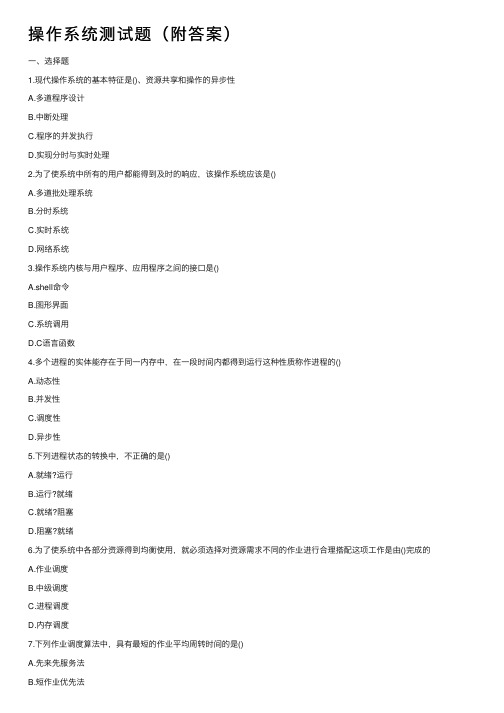
操作系统测试题(附答案)⼀、选择题1.现代操作系统的基本特征是()、资源共享和操作的异步性A.多道程序设计B.中断处理C.程序的并发执⾏D.实现分时与实时处理2.为了使系统中所有的⽤户都能得到及时的响应,该操作系统应该是()A.多道批处理系统B.分时系统C.实时系统D.⽹络系统3.操作系统内核与⽤户程序、应⽤程序之间的接⼝是()A.shell命令B.图形界⾯C.系统调⽤D.C语⾔函数4.多个进程的实体能存在于同⼀内存中,在⼀段时间内都得到运⾏这种性质称作进程的()A.动态性B.并发性C.调度性D.异步性5.下列进程状态的转换中,不正确的是()A.就绪?运⾏B.运⾏?就绪C.就绪?阻塞D.阻塞?就绪6.为了使系统中各部分资源得到均衡使⽤,就必须选择对资源需求不同的作业进⾏合理搭配这项⼯作是由()完成的A.作业调度B.中级调度C.进程调度D.内存调度7.下列作业调度算法中,具有最短的作业平均周转时间的是()A.先来先服务法B.短作业优先法C.优先数法D.时间⽚轮转法8.通常,⽤户编写的程序中所使⽤的地址是()A.逻辑地址B.物理地址C.绝对地址D.内存地址9.在分页存储管理系统中,从页号到物理块号的地址映射是通过()实现的A.段表B.页表C.PCBD.JCB 10.⽂件管理实际上是管理()A.主存空间B.辅助存储空间C.逻辑地址空间D.物理地址空间11.如果⽂件系统中有两个⽂件重名,不应采⽤()A.单级⽬录结构B.树形⽬录结构C.⼆级⽬录结构D.⾮循环图⽬录结构12.当前⽬录是/usr/meng,其下属⽂件prog/file.c的绝对路径名是()A./usr/meng/file.cB./usr/file.cC./prog/file.cD./usr/meng/prog/file.c13.引⼊缓冲技术的主要⽬的是()A.改善⽤户编程环境B.提⾼CPU的处理速度C.提⾼CPU与设备之间的并⾏程度D.降低计算机的硬件成本14.设备的打开、关闭、读、写等操作是由()完成的A.⽤户程序B.编译程序C.设备分配程序D.设备驱动程序15.控制和管理资源建⽴在单⼀系统策略基础,将计算功能分散化,充分发挥⽹络互联的各⾃治处理机性能的多机系统是()A.多处理器系统B.多计算机系统C.⽹络系统D.分布式系统16.在计算机系统中,操作系统是()A.处于裸机之上的第⼀层软件B.处于硬件之下的底层软件C.处于应⽤软件之上的系统软件D.处于系统软件之上的⽤户软件17.以下著名的操作系统中,属于多⽤户、多进程、多任务分时系统的是()A.DOS系统B.Windows NT系统C.UNIX系统D.OS/2系统18.下列系统中,属于实时系统的是()A.⽅正排版系统B.计算机辅助设计系统C.⽕车订票系统D.办公⾃动化系统19.引⼊多道程序的⽬的在于()A.充分利⽤CPU,减少CPU等待时间B.提⾼实时响应速度C.有利于代码共享,减少主、辅存信息交换量D.充分利⽤存储器20.在操作系统中引⼊"进程"概念的主要⽬的是()A.改善⽤户编程环境B.描述程序动态执⾏过程的性质C.使程序与计算过程⼀⼀对应D.提⾼程序的运⾏速度21.若P、V操作的信号量S初值为2,当前值为-1,则表⽰有()个等待进程A.0B.lC.2D.322.作业调度的关键在于()A.选择恰当的进程管理程序B.选择恰当的作业调度算法C.⽤户作业准备充分D.有⼀个较好的操作环境23.有三个作业同时到达,J1,J2,J3的执⾏时间分别为T1,T2,T3,且T1 T2 T3,它们在⼀台处理机上按单道⽅式运⾏,采⽤短作业优先算法,则平均周转时间是()A.T1+T2+T3B.(T1+T2+T3)/3C.T1+2′T2/3+T3/3D.T1/3+2′T2/3+T324.若处理器有32位地址,则它的虚拟地址空间为()字节A.2GBB.4GBC.100KBD.640KB25.除操作系统占⽤的内存空间之外,所剩余的全部内存只供⼀个⽤户进程使⽤,其他进程都放在外存上,这种设计称为()A.覆盖技术B.虚拟技术C.对换技术D.物理扩充26.⽂件系统为每个⽂件建⽴⼀张指⽰逻辑记录和物理记录之间的对应关系表,由此表和⽂件本⾝构成的⽂件是()A.连续⽂件B.串连⽂件C.索引⽂件D.逻辑⽂件27.使⽤绝对路径名访问⽂件是从()开始按⽬录结构访问某个⽂件A.当前⽬录B.⽤户主⽬录C.根⽬录D.⽗⽬录28.⽤户程序与实际使⽤的物理设备⽆关,由操作系统考虑因实际设备不同⽽需要使⽤不同的设备驱动程序,这是由设备管理的()功能实现的A.设备独⽴性B.设备分配C.缓冲管理D.虚拟设备29.引⼊缓冲技术的主要⽬的是()A.改善⽤户编程环境B.提⾼CPU的处理速度C.提⾼CPU与设备之间的并⾏程度D.降低计算机的硬件成本30.以下不属于分布式系统特征的是()A.分布性B.并⾏性C.全局性D.可定制性31.操作系统核⼼部分的主要特点是( )。
计算机操作系统试题及答案

计算机操作系统试题及答案一、选择题1、操作系统是一种()。
A 应用软件B 系统软件C 工具软件D 调试软件答案:B操作系统是管理计算机硬件与软件资源的程序,是直接运行在“裸机”上的最基本的系统软件,任何其他软件都必须在操作系统的支持下才能运行。
2、以下不属于操作系统主要功能的是()。
A 进程管理B 存储管理C 设备管理D 文字处理答案:D操作系统的主要功能包括进程管理、存储管理、设备管理、文件管理和作业管理等。
文字处理通常是由专门的文字处理软件来完成,不是操作系统的主要功能。
3、在多道程序设计环境中,操作系统分配资源以()为基本单位。
A 程序B 进程C 作业D 指令答案:B进程是操作系统进行资源分配和调度的基本单位。
4、下列进程状态的转换中,不正确的是()。
A 就绪→运行B 运行→就绪C 运行→阻塞D 阻塞→运行答案:D进程状态的转换中,阻塞状态不能直接转换为运行状态,必须先转换为就绪状态,然后再被调度为运行状态。
5、临界区是指()。
A 一段程序B 一段数据区C 一种同步机制D 访问共享资源的程序段答案:D临界区是指访问共享资源的程序段,在这段程序中,进程可能会改变共享变量的值。
6、采用时间片轮转调度算法时,时间片过大,系统的性能将会()。
A 降低B 提高C 不变D 不确定答案:A时间片过大,会使得每个进程都能在一个时间片内完成大部分工作,导致进程切换次数减少,系统的响应时间变长,性能降低。
7、下面关于死锁的论述中,正确的是()。
A 死锁是指系统中多个进程无限期地等待永远不会发生的条件B 死锁是指系统中多个进程竞争资源而产生的一种僵持状态C 死锁是指系统中多个进程同时被阻塞,并永远无法唤醒D 死锁是指系统中多个进程相互等待对方释放资源答案:D死锁是指多个进程在运行过程中因争夺资源而造成的一种僵局,若无外力作用,这些进程都将无法向前推进,即相互等待对方释放资源。
8、以下存储管理方式中,会产生内部碎片的是()。
操作系统试题及答案
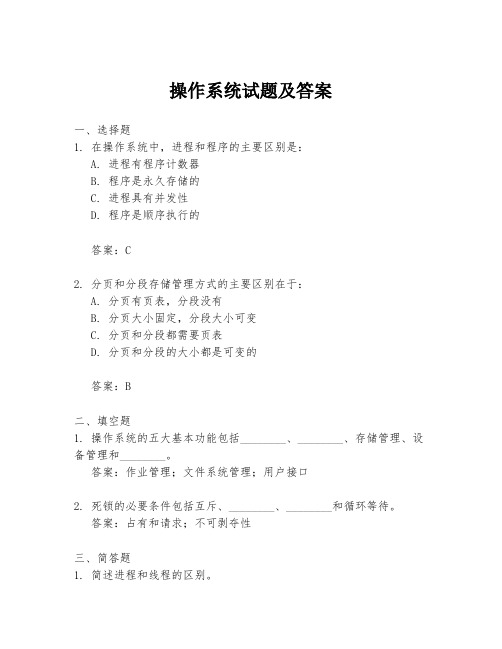
操作系统试题及答案一、选择题1. 在操作系统中,进程和程序的主要区别是:A. 进程有程序计数器B. 程序是永久存储的C. 进程具有并发性D. 程序是顺序执行的答案:C2. 分页和分段存储管理方式的主要区别在于:A. 分页有页表,分段没有B. 分页大小固定,分段大小可变C. 分页和分段都需要页表D. 分页和分段的大小都是可变的答案:B二、填空题1. 操作系统的五大基本功能包括________、________、存储管理、设备管理和________。
答案:作业管理;文件系统管理;用户接口2. 死锁的必要条件包括互斥、________、________和循环等待。
答案:占有和请求;不可剥夺性三、简答题1. 简述进程和线程的区别。
答案:进程是操作系统进行资源分配和调度的一个独立单位,是程序的执行实体。
线程是进程中的一个实体,是CPU调度和执行的单位,比进程更小的能独立运行的基本单位。
线程自身基本上不拥有系统资源,只拥有一点在运行中必不可少的资源(如执行栈),但它可以与同属一个进程的其他线程共享进程所拥有的全部资源。
2. 描述虚拟内存的工作原理。
答案:虚拟内存是一种内存管理技术,它允许操作系统将虚拟地址空间映射到物理内存。
操作系统通过页面置换算法,将当前不活跃的内存页面交换到磁盘上,从而为当前活跃的页面腾出空间。
这样,应用程序可以使用的地址空间就可以大于实际的物理内存大小。
四、计算题1. 假设一个系统有16个页面,页面大小为4KB,主存大小为256KB。
如果一个程序的页表有32个页表项,计算该系统的页表大小。
答案:每个页表项通常包含一个指向页面的指针,假设指针的大小为4字节。
因此,32个页表项的总大小为32 * 4 = 128字节。
页表大小为128KB。
2. 如果一个系统采用二级页表,主存大小为4GB,页面大小为4KB,计算需要多少个一级页表项和二级页表项。
答案:首先,计算一级页表项的数量:4GB / (4KB * 1024) = 1M个一级页表项。
操作系统试题及答案

操作系统试题及答案一、选择题1. 操作系统的主要功能是()A. 实现计算机与外部设备的交互B. 管理计算机的硬件资源C. 控制计算机的运行流程D. 以上答案都正确答案:D2. 下列哪个不属于操作系统的基本功能()A. 进程管理B. 文件管理C. 硬件管理D. 内存管理答案:C3. 操作系统的进程是指()A. 计算机运行的一个程序B. 计算机运行的多个程序C. 计算机运行的最核心程序D. 计算机运行的最后一个程序答案:B4. 下列哪个不是进程状态()A. 运行态B. 就绪态C. 阻塞态D. 结束态答案:D5. 操作系统的调度算法是指()A. 确定进程的执行顺序B. 操作系统的启动顺序C. 进程与外设的交互顺序D. 确定进程的创建顺序答案:A二、填空题1. 操作系统内核是指()。
答案:操作系统的核心部分,负责管理计算机的硬件资源和提供基本的系统调用接口。
2. 进程的状态包括()。
答案:运行态、就绪态、阻塞态。
3. 进程调度算法的目标是()。
答案:提高系统的吞吐量、减少响应时间、提高系统的公平性。
4. 死锁是指进程()。
答案:由于竞争有限的资源而陷入无法继续执行的状态。
5. 虚拟内存是一种()。
答案:将进程的部分或全部地址空间放在磁盘上,以此扩充实际内存的技术。
三、简答题1. 请简要说明进程和线程的区别。
答案:进程是计算机运行的一个程序,包括代码、数据和运行状态等;线程是进程的一部分,是程序执行的最小单位。
一个进程可以包含多个线程,它们共享进程的资源,但拥有各自的执行路径和栈空间。
线程之间的切换开销较小,可以提高系统的并发性。
2. 简述死锁的条件以及解决死锁的方法。
答案:死锁的条件包括互斥、持有并等待、不可剥夺和循环等待。
解决死锁的方法有预防、避免、检测和恢复等。
预防死锁可以通过破坏死锁条件来实现,如破坏循环等待;避免死锁可以通过资源分配策略来避免产生死锁;检测死锁可以通过资源分配图等方法来检测死锁的发生;恢复死锁可以通过资源抢占和进程终止等方式来解除死锁。
计算机操作系统试题库(最全)
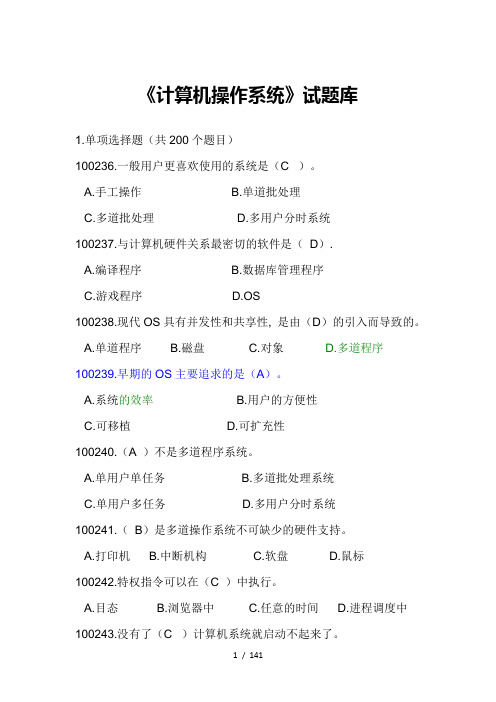
《计算机操作系统》试题库1.单项选择题(共200个题目)100236.一般用户更喜欢使用的系统是(C )。
A.手工操作B.单道批处理C.多道批处理D.多用户分时系统100237.与计算机硬件关系最密切的软件是(D).A.编译程序B.数据库管理程序C.游戏程序D.OS100238.现代OS具有并发性和共享性, 是由(D)的引入而导致的。
A.单道程序B.磁盘C.对象D.多道程序100239.早期的OS主要追求的是(A)。
A.系统的效率B.用户的方便性C.可移植D.可扩充性100240.(A )不是多道程序系统。
A.单用户单任务B.多道批处理系统C.单用户多任务D.多用户分时系统100241.(B)是多道操作系统不可缺少的硬件支持。
A.打印机B.中断机构C.软盘D.鼠标100242.特权指令可以在(C )中执行。
A.目态B.浏览器中C.任意的时间D.进程调度中100243.没有了(C )计算机系统就启动不起来了。
A.编译器B.DBMSC.OSD.浏览器100244.通道能够完成(C )之间数据的传输。
cA.CPU与外设B.内存与外设C.CPU与主存D.外设与外设100245.系统的主要功能有(c)。
A.进程管理、存储器管理、设备管理、处理机管理B.虚拟存储管理、处理机管理、进程调度、文件系统C.处理机管理、存储器管理、设备管理、文件系统D.进程管理、中断管理、设备管理、文件系统100246.单处理机计算机系统中, (A )是并行操作的。
A.处理机操作和通道操作是并行的B.程序与程序C.主程序与子程序D.用户程序与操作系统程序100247.处理机的所有指令可以在(D )中执行。
A.目态B.浏览器中C.任意时间D.系统态100248.(B )功能不是操作系统直接完成的功能。
A.管理计算机硬盘B.对程序进行编译C.实现虚拟存储器D.删除文件100249.要求在规定的时间内对外界的请求必须给予及时相应的OS 是(B )。
操作系统试题库(经典版)

操作系统试题库一, 选择题第一部分:操作系统概述1.在计算机系统中,操作系统是( B ).A. 一般应用软件B.核心系统软件C.用户应用软件D.系统支撑软件2.( D )不是基本的操作系统.A,批处理操作系统B,分时操作系统C,实时操作系统D,网络操作系统3.(C )不是分时系统的基本特征:A,同时性B,独立性C,实时性D,交互性4.关于操作系统的叙述(D)是不正确的.A."管理资源的程序"B."管理用户程序执行的程序"C."能使系统资源提高效率的程序"D."能方便用户编程的程序"5.操作系统的发展过程是(A )A.设备驱动程序组成的原始操作系统,管理程序,操作系统B.原始操作系统,操作系统,管理程序C.管理程序,原始操作系统,操作系统D.管理程序,操作系统,原始操作系统6.设计批处理多道系统时,首先要考虑的是( B)A.灵活性和可适应性B.系统效率和吞吐量C.交互性和响应时间D.实时性和可靠性7.操作系统是一种(B ).A, 应用软件B, 系统软件C, 通用软件D, 工具软件8.计算机系统的组成包括(B ).A,程序和数据B, 计算机硬件和计算机软件C,处理器和内存D,处理器,存储器和外围设备9.下面关于计算机软件的描述正确的是(B ).A,它是系统赖以工作的实体B,它是指计算机的程序与文档C,位于计算机系统的最外层D,分为系统软件和支撑软件两大类10.财务软件是一种(C).A,系统软件B,接口软件C,应用软件D,用户软件11.世界上第一个操作系统是(B).A,分时系统B,单道批处理系统C,多道批处理系统D,实时系统12.批处理操作系统提高了计算机的工作效率,但(B ).A,系统吞吐量小B,在作业执行时用户不能直接干预C,系统资源利用率不高D,不具备并行性13.允许多个用户以交互使用计算机的操作系统是(A).A,分时系统B,单道批处理系统C,多道批处理系统D,实时系统14.下面关于操作系统的叙述正确的是(A ). A,批处理作业必须具有作业控制信息B,分时系统不一定都具有人机交互功能C,从响应时间的角度看,实时系统与分时系统差不多D,由于采用了分时技术,用户可以独占计算机的资源15.操作系统是一组(C ).A,文件管理程序B,中断处理程序C,资源管理程序D,设备管理程序16.现代操作系统的两个基本特征是(C)和资源共享.A,多道程序设计B, 中断处理C,程序的并发执行D, 实现分时与实时处理17.(D)不是操作系统关心的主要问题. A, 管理计算机裸机B, 设计,提供用户程序与计算机硬件系统的界面C, 管理计算机系统资源D, 高级程序设计语言的编译器18.引入多道程序的目的是(D ).A,为了充分利用主存储器B,增强系统的交互能力C,提高实时响应速度D,充分利用CPU,减少CPU的等待时间19.在多道程序设计的计算机系统中,CPU(C ).A,只能被一个程序占用B,可以被多个程序同时占用C,可以被多个程序交替占用D,以上都不对20.多道程序设计是指(B ).A,有多个程序同时进入CPU运行B,有多个程序同时进入主存并行运行C,程序段执行不是顺序的D,同一个程序可以对应多个不同的进程21.从总体上说,采用多道程序设计技术可以( )单位时间的算题量,但对每一个算题,从算题开始到全部完成所需的时间比单道执行所需的时间可能要(B).A,增加,减少B,增加,延长C,减少,延长D,减少,减少22.(A)没有多道程序设计的特点.A,DOS B,UNIX C,WINDOWS D,OS/223.下列四个操作系统中,是分时系统的为(C ).A,MS-DOS B,WINDOWS 98C,UNIX D,OS/2系统24.在分时系统中,时间片一定,( B),响应时间越长.A,内存越多B,用户数越多C,后备队列D,用户数越少25.批处理系统的主要缺点是(B ).A,CPU的利用率不高B,失去了交互性C,不具备并行性D,以上都不是26.在下列性质中,哪一个不是分时系统的特征.( C )A, 交互性B, 多路性C, 成批性D, 独占性27.实时操作系统追求的目标是( C). A,高吞吐率B,充分利用内存C, 快速响应D, 减少系统开销28.以下(C)项功能不是操作系统具备的主要功能.A,内存管理B,中断处理C,文档编辑D,CPU调度29.操作系统程序结构的主要特点是(C). A, 一个程序模块B,分层结构C, 层次模块化D,子程序结构30.操作系统负责为方便用户管理计算机系统的(C ).A, 程序B, 文档资料C, 资源D, 进程31.计算机在接受用户请求后处理数据以与在数据处理结束时,将结果送到终端显示器.例如,导弹控制系统应选择安装(C )A,批处理操作系统B,分时操作系统C,实时操作系统D,网络操作系统32.操作系统的基本职能是(A).A.控制和管理系统内各种资源,有效地组织多道程序的运行B.提供用户界面,方便用户使用C.提供方便的可视化编辑程序D.提供功能强大的网络管理工具33.分布式操作系统与网络操作系统本质上的不同在于(D ).A.实现各台计算机之间的通信B.共享网络中的资源C.满足较大规模的应用D.系统中若干台计算机相互协作完成同一任务34.Linux操作系统是著名的(B )。
国开电大《操作系统》2024期末试题

操作系统期末试题(2024春)一、单选题1.在计算机系统中,控制和管理各种资源、有效地组织多道程序运行的系统软件称作()。
A.文件系统B.操作系统C.网络管理系统D.数据库管理系统2.按照所起的作用和需要的运行环境,操作系统属于()。
A.应用软件B.用户软件C.系统软件D.支撑软件3.操作系统的基本职能是()。
A.提供功能强大的网络管理工具B.提供用户界面,方便用户使用C.提供方便的可视化编辑程序D.控制和管理系统内各种资源,有效地组织多道程序的运行4.为了使计算机系统中所有的用户都能得到及时的响应,该操作系统应该是()。
A.多道批处理系统B.实时系统C.分时系统D.网络系统5.在实时系统中,一旦有处理请求和要求处理的数据时,CPU就应该立即处理该数据并将结果及时送回。
下面属于实时系统的是()。
A.办公自动化系统B.计算机激光照排系统C.航空订票系统D.计算机辅助设计系统6.实时操作系统追求的目标是()。
A.快速响应B.充分利用内存C.高吞吐率D.减少系统开销7.操作系统内核与用户程序、应用程序之间的接口是()。
A.系统调用B.图形界面C.shell命令D.C语言函数8.进程与程序之间有密切联系,但又是不同的概念。
二者的一个本质区别是()。
A.程序是动态概念,进程是静态概念B.程序是静态概念,进程是动态概念C.程序保存在文件中,进程存放在内存中D.程序顺序执行,进程并发执行9.在单CPU系统中,若干程序的并发执行是由()实现的。
A.程序自身B.进程C.用户D.编译程序10.某进程由于需要从磁盘上读入数据而处于阻塞状态。
当系统完成了所需的读盘操作后,此时该进程的状态将()。
A.从运行变为就绪B.从阻塞变为就绪C.从阻塞变为运行D.从就绪变为运行11.进程从运行状态变为阻塞状态的原因是()。
A.输入或输出事件完成B.时间片到C.输入或输出事件发生D.某个进程被唤醒12.如果信号量S的值是0,此时进程A执行P(S)操作,那么,进程A会()。
完整word版操作系统试题及答案
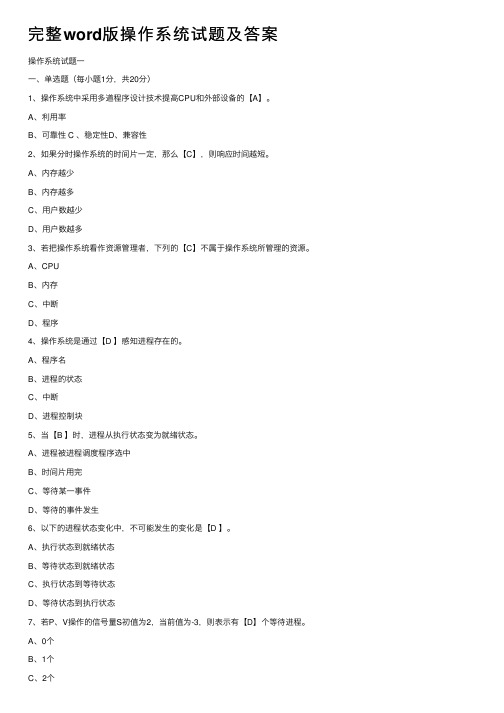
完整word版操作系统试题及答案操作系统试题⼀⼀、单选题(每⼩题1分,共20分)1、操作系统中采⽤多道程序设计技术提⾼CPU和外部设备的【A】。
A、利⽤率B、可靠性 C 、稳定性D、兼容性2、如果分时操作系统的时间⽚⼀定,那么【C】,则响应时间越短。
A、内存越少B、内存越多C、⽤户数越少D、⽤户数越多3、若把操作系统看作资源管理者,下列的【C】不属于操作系统所管理的资源。
A、CPUB、内存C、中断D、程序4、操作系统是通过【D 】感知进程存在的。
A、程序名B、进程的状态C、中断D、进程控制块5、当【B 】时,进程从执⾏状态变为就绪状态。
A、进程被进程调度程序选中B、时间⽚⽤完C、等待某⼀事件D、等待的事件发⽣6、以下的进程状态变化中,不可能发⽣的变化是【D 】。
A、执⾏状态到就绪状态B、等待状态到就绪状态C、执⾏状态到等待状态D、等待状态到执⾏状态7、若P、V操作的信号量S初值为2,当前值为-3,则表⽰有【D】个等待进程。
A、0个B、1个C、2个D、3个8、P、V操作是【A】A、两条低级进程通信原语B、两条⾼级进程通信原语C、两条系统调⽤命令D、两组不同的机器指令9、⽤V操作唤醒⼀个等待进程时,被唤醒的进程状态变为【B 】。
A、等待B、就绪C、执⾏D、完成10、资源的有序分配策略破坏【D 】条件,是⼀种死锁预防策略。
A、互斥条件B、保持和请求条件C、不剥夺条件D、环路等待条件11、银⾏家算法是⼀种【B 】算法。
A、死锁预防B、死锁避免C、死锁检测D、死锁解除12、某系统中有同类资源10个,每个进程的资源需求量为3个,则不会发⽣死锁的最⼤并发进程数为【C】A、2B、3C、4D、513、分区管理中采⽤⾸次适应分配算法时,应把空闲区按【C】次序进⾏管理。
A、⼤⼩递增B、⼤⼩递减C、地址递增D、地址递减14、很好地解决了内存碎⽚问题的存储管理⽅案是【C 】。
A、固定分区管理B、可变分区管理C、页式存储管理D、段式存储管理15、虚拟存储管理系统的基础是程序的【C】理论。
自考操作系统试题及答案

自考操作系统试题及答案一、单项选择题(每题2分,共20分)1. 在操作系统中,进程和程序的主要区别是()。
A. 进程是动态的,程序是静态的B. 进程是静态的,程序是动态的C. 进程和程序都是动态的D. 进程和程序都是静态的答案:A2. 下列关于操作系统的叙述中,错误的是()。
A. 操作系统是计算机系统中不可缺少的系统软件B. 操作系统是计算机硬件的第一层软件扩展C. 操作系统是计算机系统中的通用软件D. 操作系统是计算机系统中的应用软件答案:D3. 下列不属于操作系统提供的服务的是()。
A. 文件管理B. 设备管理C. 程序编译D. 进程管理答案:C4. 在操作系统中,用于实现多道程序设计的关键技术是()。
A. 多线程B. 多进程C. 多核处理D. 多任务答案:B5. 操作系统中,用于分配和回收内存资源的机制是()。
A. 内存分配B. 内存回收C. 内存管理D. 内存保护答案:C6. 下列选项中,不是操作系统功能的是()。
A. 进程调度B. 文件系统C. 网络通信D. 数据库管理答案:D7. 在操作系统中,负责处理用户与计算机硬件之间交互的模块是()。
A. 用户界面B. 设备驱动程序C. 系统调用D. 系统命令答案:B8. 下列关于操作系统的叙述中,正确的是()。
A. 操作系统是用户与计算机硬件之间的接口B. 操作系统是用户与应用程序之间的接口C. 操作系统是应用程序与计算机硬件之间的接口D. 操作系统是计算机硬件与应用程序之间的接口答案:A9. 在操作系统中,用于实现文件的创建、删除、读取和写入等功能的是()。
A. 文件管理B. 内存管理C. 进程管理D. 设备管理答案:A10. 下列选项中,不属于操作系统提供的资源管理功能的是()。
A. 存储管理B. 设备管理C. 作业调度D. 系统维护答案:D二、多项选择题(每题3分,共15分)1. 操作系统的主要功能包括()。
A. 进程管理B. 存储管理C. 设备管理D. 文件管理E. 作业调度答案:ABCDE2. 下列属于操作系统提供的资源管理功能的是()。
操作系统概论2024年4月真题

2024年4月高等教育自学考试全国统一命题考试操作系统概论(课程代码02323)注意事项:1.本试卷分为两部分,第一部分为选择题,第二部分为非选择题。
2.应考者必须按试题顺序在答题卡(纸)指定位置上作答,答在试卷上无效。
3.涂写部分、画图部分必须使用2B 铅笔,书写部分必须使用黑色字迹签字笔第一部分选择题一、单项选择题:本大题共 20 小题,每小题1分,共20分。
在每小题列出的备选项中只有一项是最符合题目要求的,请将其选出。
1.下面不属于...微机操作系统的是A.LinuxB.VxWorkC.MacintoshD.Chrome OS2.一条指令处理的时间称为A.指令周期B.取址周期C.执行周期D.时钟周期3.条件跳转指令执行后,PC(程序计数器)寄存器的变化情况是A.PC值加1B.PC值减1C.PC 值不变D.PC值根据条件判断结果来变化4.下面不属于...进程控制块内容的是A.进程标识符信息B.处理机状态信息C.进程调度信息D.中断向量信息5.下面关于系统调用与函数调用的说法中,正确的是A.系统调用比函数调用多了一些系统开销B.系统调用和函数调用均通过中断指令来进行C.系统调用要通过CALL指令来进行,而函数调用通过中断指令来进行D.系统调用执行完会返回调用处,而函数调用执行完不会返回调用处6.在一个采用时间片轮转调度算法的系统中,以下不会..引起进程调度的情形是A.一个进程运行结束B.一个进程阻塞C.一个进程在执行时,另一个进程进入就绪队列D.当前运行进程的时间片用完7.有3个进程P1、P2、P3,其运行时间分别是2小时、5 小时和3小时,假定同时到达,并在相同的单道批处理系统中运行,则平均周转时间最短的执行序列是A.P1、P2、P3B.P3、P2、P1C.P2、P1、P3D.P1、P3、P28.多级反馈队列进程调度算法中,就绪队列编号越大优先级越低,在CPU上运行的i级就绪队列中的进程,使用CPU时间过多,则会被移到A.i级队列队尾B.i-1级队列队尾C.i+1级队列队尾D.i+1级队列队首9.以下进程调度算法中,不能..保证紧急任务优先执行的是A.优先权调度算法B.时间片轮转调度算法C.多级队列调度算法D.多级反馈队列调度算法10.对不同类型的资源排序,要求每个进程按规定的顺序申请资源,这种死锁预防策略摒弃了死锁必要条件中的A.互斥条件B.请求和保持条件C.不剥夺条件D.环路等待条件11.操作系统实现扩充主存空间是通过A.分段存储管理技术B.分页存储管理技术C.固定分区存储管理技术D.虚拟存储管理技术12.在虚拟存储管理系统中,系统先为每个进程分配一定数量的页框,当进程发生缺页时,由系统从空闲页框中取出一个进行分配,这一过程采用的策略是A.固定分配局部置换B.可变分配全局置换C.可变分配局部置换D.固定分配全局置换13.一个分段存储管理系统中,逻辑地址长度为32位,其中段号占8位,则最大段长是A.28字节B.216字节C.224字节D.232字节14.假定系统为某进程在内存中分配了1个页框用于存放数据,初始时程序在内存而数据均不在内存,每个页框可以存 100个整数,矩阵A按行存放,那么执行以下程序发生的缺页次数为for j=1 to 100for i=1 to 100A[i,j]=0A.1B.100C.1000D.1000015.某计算机系统按照字节编址,采用二级页表的分页存储管理方式,其中逻辑地址由10 位的页目录号、10位的页号以及12位的页内偏移组成,那么该系统中物理内存的页框大小为A.210字节B.212字节C.220字节D.232字节16.使用绝对路径名访问文件时,查找文件的开始点是A.当前目录B.用户主目录C.上级目录D.根目录17.以下能将数据加到文件末尾的文件操作是A.OPENB.APPENDC.READD.SEEK18.在文件系统中,i结点这种数据结构中存放的内容是A.文件的第一块数据所在簇的簇号B.文件属性和文件块的磁盘地址C.文件所有数据块所在簇的簇号D.文件所有数据块的大小19.下列设备中,属于块设备的是A.打印机B.显示器C.硬盘D.键盘20.磁盘设备工作时,为完成一个磁盘服务请求,需将指定扇区移动到磁头下面,该过程所经历的时间称为A.寻道时间B.传输时间C.访问时间D.旋转延迟时间第二部分非选择题二、填空题:本大题共 10 小题,每小题2分,共20分。
操作系统考试试题
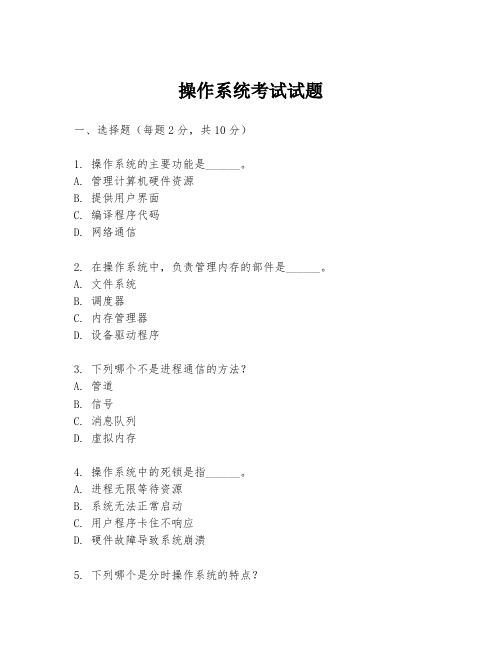
操作系统考试试题一、选择题(每题2分,共10分)1. 操作系统的主要功能是______。
A. 管理计算机硬件资源B. 提供用户界面C. 编译程序代码D. 网络通信2. 在操作系统中,负责管理内存的部件是______。
A. 文件系统B. 调度器C. 内存管理器D. 设备驱动程序3. 下列哪个不是进程通信的方法?A. 管道B. 信号C. 消息队列D. 虚拟内存4. 操作系统中的死锁是指______。
A. 进程无限等待资源B. 系统无法正常启动C. 用户程序卡住不响应D. 硬件故障导致系统崩溃5. 下列哪个是分时操作系统的特点?A. 多用户同时使用B. 任务切换非常快速C. 系统资源分配给单个用户D. 面向批处理作业二、填空题(每题2分,共10分)1. 操作系统中,______是一种将程序分成小段执行,以提高内存利用率和系统响应速度的技术。
2. 在多任务操作系统中,______是保证系统资源公平分配的机制。
3. 操作系统通过______来控制和管理对硬件设备的访问。
4. 在操作系统中,______是指操作系统为完成任务而设置的一系列程序和数据。
5. 操作系统的______是指系统能够同时处理多个作业的能力。
三、简答题(每题10分,共30分)1. 请简述操作系统的五大基本功能。
2. 描述进程和线程的区别。
3. 解释虚拟内存的概念及其作用。
四、论述题(20分)请论述操作系统中调度算法的两种主要类型及其特点,并举例说明它们在实际系统中的应用。
五、案例分析题(30分)某公司有多个部门,每个部门有多个员工使用计算机进行日常工作。
为了提高工作效率,公司决定实施一套集中管理的操作系统策略。
请分析并提出一个合理的操作系统部署方案,包括但不限于用户权限管理、数据安全、系统维护等方面。
注:请根据上述题型撰写答案,确保答案准确、完整。
操作系统原理考试试题

操作系统原理考试试题一、选择题(每题 2 分,共 40 分)1、以下不属于操作系统主要功能的是()A 进程管理B 存储管理C 文档编辑D 设备管理2、在分时操作系统中,()是衡量系统性能的一个重要指标。
A 响应时间B 周转时间C 吞吐量D 资源利用率3、操作系统中的进程状态不包括()A 就绪状态B 执行状态C 等待状态D 完成状态4、死锁产生的四个必要条件中,不包括()A 互斥条件B 请求和保持条件C 不剥夺条件D 循环等待条件E 无序分配条件5、以下存储管理方式中,会产生内部碎片的是()A 分段存储管理B 分页存储管理C 段页式存储管理D 可变分区存储管理6、在请求分页存储管理中,页面置换算法不包括()A 最佳置换算法B 先进先出置换算法C 最近最久未使用置换算法D 随机置换算法7、以下文件物理结构中,不支持随机访问的是()A 顺序结构B 链接结构C 索引结构D 多重索引结构8、设备管理中,SPOOLing 技术是为了()A 提高设备利用率B 减轻用户编程负担C 提高 CPU 与设备并行工作能力D 提供虚拟设备9、操作系统中,进程控制块(PCB)不包含的信息是()A 进程优先级B 进程状态C 进程代码D 进程标识符10、以下哪种调度算法有利于短作业优先执行()A 先来先服务调度算法B 短作业优先调度算法C 高响应比优先调度算法D 时间片轮转调度算法11、虚拟存储技术的基础是()A 程序局部性原理B 时间局部性原理C 空间局部性原理D 以上都是12、以下关于文件系统的说法,错误的是()A 文件系统负责文件的存储、检索和更新B 文件系统可以保证文件的安全性和完整性C 文件系统可以提高文件的访问效率D 文件系统不需要考虑磁盘空间的管理13、在操作系统中,()是一种同步机制。
A 信号量B 管道C 消息队列D 共享内存14、以下关于操作系统内核的说法,正确的是()A 内核是操作系统的核心部分,提供最基本的服务B 内核运行在用户态C 内核不负责进程管理D 内核不处理中断15、以下哪种情况下,会发生缺页中断()A 访问的页面在内存中B 访问的页面不在内存且内存已满C 访问的页面不在内存且内存未满D 以上都不是16、以下关于磁盘调度算法的说法,正确的是()A 先来先服务调度算法公平但效率较低B 最短寻道时间优先调度算法可能导致饥饿现象C 扫描算法(电梯算法)可以避免饥饿现象D 以上都对17、以下关于进程通信的说法,错误的是()A 共享内存速度快但需要同步机制B 消息传递灵活但开销较大C 管道只能用于父子进程之间的通信D 信号量主要用于进程同步18、操作系统中的地址重定位分为()A 静态重定位和动态重定位B 逻辑重定位和物理重定位C 绝对重定位和相对重定位D 直接重定位和间接重定位19、以下关于操作系统启动过程的说法,错误的是()A 首先进行硬件自检B 然后加载操作系统内核C 接着初始化设备驱动程序D 最后执行用户程序20、以下哪种文件类型通常用于存储可执行程序()Atxt Bdoc Cexe Djpg二、填空题(每题 2 分,共 20 分)1、操作系统为用户提供的接口有_____和_____。
操作系统测试题(附答案)

操作系统测试题(附答案)一、单选题(共IOO题,每题1分,共100分)1、一次中断后可能引起若干个进程状态的变化,因此中断处理后,由()决定哪个进程可占用处理器。
A、进程调度B、移臂调度C、页面调度D、作业调度正确答案:A2、某系统正在执行三个进程P1、P2和P3,各进程的计算时间和I/O时间比进例如下表所示。
为提高系统资源利用率,合理的进程优先级设置应为()o程计算时间I/O时间P190%10%P250%50%P315%85%A、P2>P1=P3B、P1>P2=P3C、P1>P2>P3D、P3>P2>P1正确答案:D3、操作系统采用分页存储管理方式,要求()oA、每个进程拥有一张页表,且进程的页表驻留在内存中B、每个进程拥有一张页表,但只有执行进程的页表驻留在内存中C、所有进程共享一张页表,以节约有限的内存空间,但页表必须驻留在内存中D、所有进程共享一张页表,只有页表中当前使用的页面必须驻留在内存中正确答案:A4、分区管理要求为每一个作业都分配()的主存单元。
A、若干地址不连续B、若干连续的页C、若干不连续的帧D、地址连续正确答案:D5、下列关于父进程和子进程的叙述中,正确的是()oA、子进程执行完了,父进程才能执行B、父进程创建了子进程,因此父进程执行完了,子进程才能执行C、撤销子进程时,应该同时撤销父进程D、撤销父进程时,应该同时撤销子进程正确答案:D6、资源的按序分配策略可以破坏()条件。
A、不剥夺B、环路等待C、互斥D、请求和保持正确答案:B7、()用于连接大量的低速和中速I/O设备。
A、数组选择通道B、字节选择通道C、字节多路通道D、数组多路通道正确答案:C8、由磁头进行读写完成信息传送的时间是()oA、优化时间B、查找时间C、传输时间D、等待时间正确答案:C9、wait、SignaI操作是一种()。
A、机器指令B、低级进程通信原语C、作业控制命令D、系统调用命令正确答案:B10、建立多进程的主要目的是提高()的利用率。
完整 计算机操作系统试题及答案
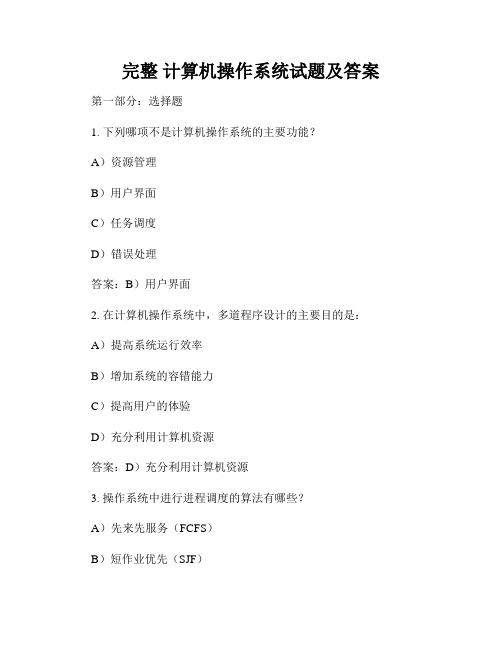
完整计算机操作系统试题及答案第一部分:选择题1. 下列哪项不是计算机操作系统的主要功能?A)资源管理B)用户界面C)任务调度D)错误处理答案:B)用户界面2. 在计算机操作系统中,多道程序设计的主要目的是:A)提高系统运行效率B)增加系统的容错能力C)提高用户的体验D)充分利用计算机资源答案:D)充分利用计算机资源3. 操作系统中进行进程调度的算法有哪些?A)先来先服务(FCFS)B)短作业优先(SJF)C)最高优先权优先(HPF)D)所有选项都对答案:D)所有选项都对4. 在操作系统中,进程是什么概念?A)程序的实例B)程序执行时的指令集合C)CPU执行的任务D)没有正确选项答案:A)程序的实例5. 磁盘调度算法中,哪种算法可以使得磁盘的平均寻道时间最小?A)先来先服务(FCFS)B)最短寻道时间优先(SSTF)C)扫描算法(SCAN)D)循环扫描算法(C-SCAN)答案:B)最短寻道时间优先(SSTF)第二部分:填空题1. 在进程控制块(PCB)中,保存了进程的______等信息。
答案:状态(状态包括就绪、运行、阻塞等)2. 操作系统中,_____是指在主存储器中为进程分配地址空间。
答案:内存管理3. 系统调用是操作系统提供给应用程序的一种______。
答案:编程接口4. 在页面置换算法中,产生缺页中断时,会调用______。
答案:页面置换算法5. 在资源分配中,______是指一个进程因等待系统资源而无法继续执行的状态。
答案:阻塞状态第三部分:简答题1. 请简要解释进程与线程的区别和联系。
答案:进程是操作系统中的基本执行单元,拥有独立的地址空间和资源,可以独立运行。
线程是进程中的一部分,由进程创建和调度,共享进程的地址空间和资源,线程之间的切换开销较小。
进程可以包含多个线程,线程之间可以共享数据,提高了程序的并发性和效率。
2. 请简要解释死锁的产生条件,以及常见的死锁解决方法。
答案:死锁产生的条件包括互斥条件(资源只能被一个进程占用)、占有且等待条件(进程占有资源并等待其他资源)、不可剥夺条件(资源不能被剥夺)、循环等待条件(存在进程之间的循环等待关系)。
- 1、下载文档前请自行甄别文档内容的完整性,平台不提供额外的编辑、内容补充、找答案等附加服务。
- 2、"仅部分预览"的文档,不可在线预览部分如存在完整性等问题,可反馈申请退款(可完整预览的文档不适用该条件!)。
- 3、如文档侵犯您的权益,请联系客服反馈,我们会尽快为您处理(人工客服工作时间:9:00-18:30)。
Operating Systems Fall 2009 Midterm ExaminationName Student No. ScoreProblem 1: Booting (4Points)Turn on Bochs, and running JOS, JOS will first enter the 16-bit real mode. After execute several instructions, JOS will turn into 32-bit protected mode and fall into i386_init() function .1. How does processor translate virtual address to physical address in16-bits real mode, please give an example? (2’)Real Mode: physical addr = 16 * segment + offset Example:0xf000:0xe05b16*0xf000+0x e05b = 0xf e05b2. How does processor translate virtual address to physical address in32-bits protected mode, please give an example? (2’)Protected Mode: each segment is assigned an entry in a descriptor table. The index of the entry of the segment is the selector value that is stored in segment registers.Example: (no paging) CS + base = 0x22 descriptor table[0x22] = 0x1000 Virtual address = 0x89014 Physical address = 0x1000 + 0x89014 = 0x 90014CS + base Physical addr = Segment start addr + offsetThe xv6’s system call stubs (sheet 27) are called by user-space C code as if they were ordinary C functions, so all callers are prepared for the stubs to not preserve caller-saved registers. The stubs invoke the INT instruction which vectors into kernel code that shortly jumps to alltraps (line 2755). alltraps and trapret save and restore all registers to and from a struct trapframe.1.As we know, the return value is saved in %eax, how does the systemcall return a value to user process through %eax? (2’)cp−>tf−>eax = syscalls[num](); (sheet 27)2.If the user process wants the kernel return a string of “Good Luck”, whatshould user process provide and how does the kernel return certain string to user? (3’)User process provide a buf[10] and transfer it to the kernel as a pointer. The kernel copies the “Good Luck” string into buf and returns a success. Then the user process can read the string in buf.In the backtrace function, we can print out the back trace of the program. Suppose we have following call trace:foo(int b) -> bar(int a) -> backtrace() The functions’ code address range list below.A partial code and stack are as follows:Fill in the blanks ([1-3], 2’ * 3) and answer the question. [1][2][3] . 1. What is the input argument of bar function? (2’) 13/0xd2. What is %esp value after the backtrace function returns? (2’) 0xffffc9b80xffffc9c0Current %ebpProblem 4: Thread Libraries (19Points)Thread is a useful concept to allow memory sharing among tasks. However, designing and implementing a thread library is fairly difficult. Read the following text and answer the questions:1.What are the differences between a kernel and a user thread? (3’)Kernel thread is a real execution context (it has cr3, kernel context, etc.). However, user thread is completely managed at the user level, from the kernel’s point of view, they exist in one process.The mapping from kernel threads to user threads is an important choice in thread library. For example, GNU portable thread library maps N user threads onto one kernel thread.2.What is the major advantage of choosing this mapping? (3’)1st, the operations are all done in user level, without trapping to kernel. 2nd, the context switching is quite lightweight. Finally, user level thread scheduler allows flexible and highly customizable scheduling of the threads.3.In what situation this mapping may become a bad choice, and why?Please give at least one concrete example (i.e. scenario) to justify that this is a bad choice. (3’)One thread calling into the kernel will block all other threads, even if some threads are ready to run.4.Native POSIX Thread Library (NPTL) on Linux adopts a 1-1 mapping,what are the pros and cons of this approach? (3’)Pros:1)Thread can directly calls system services (e.g. sleep), withoutworrying about interfering with other threads.2)Better system integration. (Compare to user threads that built uponkernel threads)Cons:1)Extra trap to kernel on every thread operation.2)The scheduling of kernel threads may interfere with user threads.Kernel may schedule away a kernel thread associated with certainuser threads, while do not telling them. However, the user thread may be ready to run!3)It is inflexible and inefficient to customize the scheduling of userthreads, since we must frequently invoke system calls to do that.It has been argued that “mapping some kernel threads to user ones” is indeed not the correct way for implementing a really flexible and fast thread library, so:5.What is the major problem of associating a user thread into a kernelthread? (Hint: user threads and kernel threads may each have their own schedulers) (4’)The scheduling of kernel thread is oblivious to user threads.6.Based on your answer (observation) above, try to devise a newapproach to combine the advantages of different mapping methods.You should describe your approach by showing its difference with mapping user threads to kernel ones. (3’)The kernel threads should not schedule themselves, rather, they should direct important events to user scheduler (for example, the kernel thread is blocking now). The user scheduler completely decides the scheduling of threads based on these events (for example, assigning a new kernel thread to a ready user thread).Problem 5: Synchronization (20Points)There are three kinds of lock implementation below. Read the code and answer the questions please. (4’)1.When should we use implementation-1, and when should we useimplementation-2? (2’)UniprocessorMultiprocessor & uniprocessor2.What is guard variable used in implementation-3, and what are thebenefits of implementation-3? (2’)Guarantee exclusive execute the lock code.Minimize the busy wait timeConditional variable is a good way to do the synchronization. PTHREAD library has its own implementation of conditional variable and it gives the interface belowint pthread_cond_signal(pthread_cond_t *cond);Description: Restarts one of the threads that are waiting on the condition variable cond.int pthread_cond_wait(pthread_cond_t *cond, pthread_mutex_t *mutex); Description: Atomically unlocks the mutex (as per pthread_unlock_mutex) and waits for the condition variable cond to be signaled.Assume there are two threads and one shared variable counter. One thread is used to increase the counter and the other is used to decrease it. They use the conditional variable to do the synchronization. The code is like below. Please read the code and answer the questions:(3’)The code is like:“if(count==0)pthread_cond_signal(&count_nonzero);”It should be in the lock protection area. Otherwise it will be hang because of the lost of the signal.2.Can you fix up the code to have a right result? (3’)increment_count_thr:pthread_mutex_lock(&count_lock);if (count == 0) {pthread_cond_signal (&count_nonzero);}count = count+1;pthread_mutex_unlock (&count_lock);In parallel computing, a readers-writer lock is a synchronization primitive that solves one of the readers-writers problems. A readers-writer lock is like a mutex, in that it controls access to some shared memory area, but it allows multiple threads to read from the shared area concurrently.If a thread wants to read the shared data, he must get the lock in the read mode and more than one reader threads can get this lock in the reader mode at the same time. But only one writer thread can get this lock at a time if he wants to modify the shared data.Example:The rwlock_t data structure is like this:Working flow:Your job here is to implement read_lock() function, write_lock() function and un_lock() function to meet the requirements below:1)read_lock function is used to get the rwlock into the read-mode. Thebehavior of this function is like this:Check if the lock is in the write mode or any writer thread is queued.If YES then queue itself and wait. If there is no writer queued and the lock is not in the write mode, then it increases the read numbercounter and the lock is in the read-mode now.2)write_lock function is used to get the rwlock into the write-mode.The behavior of this function is like this:Check if the lock is in the write mode or in the read mode. If YES then queue itself to wait the reader or writer to finish. If the lock is free,then get the lock into the write mode.3)un_lock function is used to unlock the rwlock. The behavior of thisfunction is like this:If the lock is in the read mode, decrease the reader number counter else if in the write mode, reset the writer number counter to zero. He must wake up the queued writer first, if no writer queued then wake up the queued reader.Problem Description: Suppose we have provided following functionsQuestions: (10’)Please implement the read_lock(), write_lock() and un_lock() functions with the given method. Don’t forget to meet the requirementsvoid read_lock(rwlock_t *rwlock){spin_lock(&rwlock->lock); // (1’)while(1){if((rwlock->nr_writers==0) // (1’)&&(is_empty(&rwlock->writers_queue)) ) {rwlock->nr_readers++;Break;}enqueue(&rwlock->reads_queue);spin_unlock(&rwlock->lock); // ( 1’)suspend();spin_lock(&rwlock->lock);}spin_unlock(&rwlock->lock);}void write_lock(rwlock_t *rwlock){spin_lock(&rwlock->lock); // (1’)while(1) {if((rwlock->nr_writers==0) // (1’)&&(rwlock->nr_readers==0)) ){rwlock->nr_writers = 1;break;}enqueue(&rwlock->writers_queue);spin_unlock(&rwlock->lock); // (1’)suspend();spin_lock(&rwlock->lock);}spin_unlock(&rwlock->lock);}void un_lock(rwlock_t *rwlock){queue *tmp_q;spin_lock(&rwlock->lock); // (1’)if(Rwlock->nr_writers) // (1’)rwlock->nr_writers = 0;elserwlock->nr_readers --;if(!is_empty(&rwlock->writers_queue)){ //(1’) (the wake up order) tmp_q = rwlock->writers_queue;rwlock->writers_queue = NULL;spin_unlock(&rwlock->lock);} else if(!is_empty(&rwlock->readers_queue)) { // (1’) tmp_q = rwlock->readers_queue;rwlock->readers_queue = NULL;spin_unlock(&rwlock->lock);} elsespin_unlock(&rwlock->lock);while(!is_empty(tmp_q))wakeup(dequeue(tmp_q));}Problem 6: Memory (12Points)1.Physical memory management is one important part of operatingsystem. In Lab 2 you have implemented a simple physical memory management policy, please describe the main work of allocating a new page and freeing a used page. (6’)page_alloc():1)Remove one struct Page from page_free_list2)Initialize the page, including setting the links to null and reference countto 0.page_free():1)If reference count is nonzero, do not free (optional)2)Add the page to the page_free_list.2.Suppose the architecture provides a feature that each TLB entry is tagged with an address space number, which identifies a unique address space. Consider a multi-process environment, what benefits will this mechanism bring in? (3’) Could you provide other approach to enjoy the same benefits but with different mechanism like flags in page table entries? (3’)(Hint: what will OS do when switching from one process to another?) Benefits: When switching address space, flush is required for untagged TLBs, if each TLB entry is tagged with an address space number, no flush is required since virtual addresses in different address spaces will have different entries.One example of optimizations related TLB flush: each x86 page directory and page table entry has a global flag, which sets the corresponding page as a global page. Global pages are not flushed from the TLB on a task switch or a write to CR.Problem 7: Durability and Consistency (22points)1.Explain terms of durability and atomicity, how to enforce durability andatomicity of file system operation? (4’)Durability means if an operation is performed and committed, it will survive permanently on disk. Atomicity means the effect of operation is either visible or none. To enforce durability, a partially solution is using synchronized I/O. To enforce atomicity, old data is copied and updates are performed on copied data, the last update using atomic instruction to redirect old pointer to the new one.2.List all detailed operations (inode, bitmap, name resolve, etc) of creatinga file named foo under /a/b/ directory in xv6 file system, that is, aftercreating file, it becomes /a/b/foo. (6’)First call namei() to resolve path “/a/b/”, in function namei(), get first inode of “/”, list all entry under “/” and get inode of “/a/”, then list all entry under “/a/” and get inode of “/a/b/” and return this inode. Second, allocate an inode for new file foo and mark this inode in-use in bitmap. Third, update the inode returned from namei()’s dentry, make a new entry point to this ne w inode. Now, a new empty file is created, writing to this file will allocate addition data blocks and update inode of this file.Orders of operations are crucial to durability and consistency in file systems. When ordering the operations, there are three simple rules:1)Never point to a structure before it has been initialized.2)Never reuse a resource before nullifying all previous pointers to it.3)Never reset the last pointer to a live resource before a new pointerhas been set.While enforcing the orders, dependency cycle is easily generated, consider the simple example: (Creating file A and removing file B gives a dependency cycle.)Now, answer the following questions:3.How xv6 file system solves the problem above? Is there any bettersolution to solve the problem above? (8’)In fact, xv6 cannot have dependency cycle, since it uses synchronized IO, when the first create file A finished, in disk block is already updated. Better solution:4.Suppose we have a program running on xv6Here is disk writes caused by this program:-bwrite file inode-bwrite dentry-bwrite in-use bitmap-bwrite data block-bwrite file inodeTwo of these five operations can be swapped, point the operations and explain your answer. (4’)Recall all rulesa)Initialize a new inode before creating dirent.b)Delete dirent before marking inode free.c)Mark block in-use before adding it to inodeaddrs[].d)Remove block from inodeaddrs[] before marking free.e)Zero blocks before marking free.Rule a) says that 1 and 2 cannot be swapped; rule c) says that 3 and 5 cannot be swapped. Both 2&3, 3&4 can be swapped, because them satisfy ordering enforcement.Problem 8: Course Survey(8points)Thank you for choosing the OS course. Your options are of great importance for us to improve the course. Please answer the following questions about the course: (You will get full credit if you answered the questions with more than one sentence)1.Did you ever compiled and ran xv6? Did you read through its code? (2')2.Which aspect do you love most in this course? (2')3.Which aspect do you dislike most in this course? (2')4.Please provide at least one suggestion on the course. (2')。
